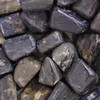Product Description
Aventurine Blue, Dark Blue Tumbled Stone .75"-1.25"
Mineral Information:
Blue aventurine is a variety of aventurine, a form of quartzite that belongs to the chalcedony family. It is characterized by its blue color, which is caused by the inclusion of other minerals or crystals within the quartz matrix.
The word "quartzite" is often used by geologists to refer to rocks that are metamorphic in nature and comprised almost entirely of quartz. Due to the fact that it is composed almost entirely of quartz, quartz and quartzite are often used interchangably.
The blue color of aventurine is usually attributed to the presence of microscopic inclusions of minerals such as fuchsite, hematite, or dumortierite. These inclusions scatter light within the quartz, giving it a shimmering and iridescent appearance.
Metaphysical Meaning:
Blue aventurine is associated with enhancing communication and self-expression. It is believed to stimulate clear and effective communication, aiding in expressing oneself with clarity and confidence. Blue aventurine is also said to enhance inner vision, intuition, and psychic abilities. It may help develop one's intuitive perception and facilitate insights and understanding on a deeper level. In addition blue aventurine is thought to have a calming and soothing effect on the mind and emotions. It is believed to help reduce stress, anxiety, and promote a sense of inner peace and tranquility.
Mineral Care:
Blue aventurine, like other varieties of quartz, is relatively durable and resistant to breakage. Quartz has a hardness of 7 on the Mohs scale, which indicates its ability to withstand scratching and abrasion.
However, the fragility of blue aventurine can depend on several factors, including the specific minerals or inclusions causing the blue color and the quality of the quartz specimen itself.
If the inclusions within the blue aventurine are delicate or have a lower hardness compared to quartz, they may be more prone to breakage. For example, if the blue color is caused by fragile minerals such as fuchsite or dumortierite, they might be more susceptible to fracturing or chipping if subjected to excessive force or pressure.
Additionally, the overall structure and quality of the blue aventurine specimen can influence its fragility. Specimens that have fractures, weaknesses, or other structural flaws may be more vulnerable to breakage.
While blue aventurine is relatively durable, it is still recommended to handle it with care. Avoid exposing it to sharp impacts, extreme temperature changes, or rough handling that could potentially cause damage or breakage. Storing blue aventurine in a protective pouch or wrapping it in a soft cloth can help prevent accidental damage.
It's important to note that the fragility of blue aventurine can vary depending on the specific specimen, so it is advisable to assess each individual piece and take appropriate precautions to ensure its preservation.
Disclaimer:
No information here is intended to diagnose, treat or cure ailments or afflictions of any kind. One should always consult a medical professional if a serious issue presents itself.







